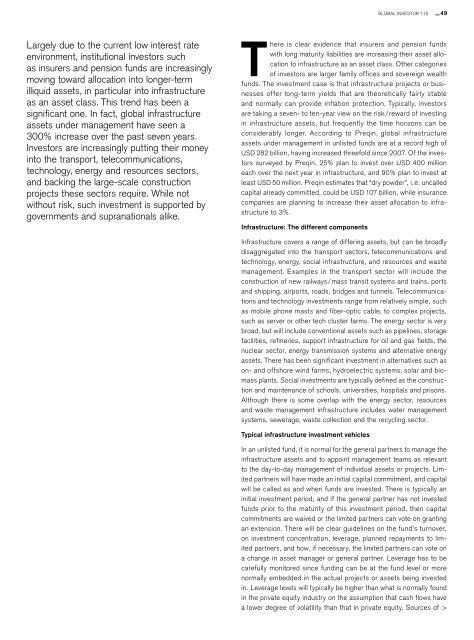Illiquid assets
Unwrapping alternative returns Global Investor, 01/2015 Credit Suisse
Unwrapping alternative returns
Global Investor, 01/2015
Credit Suisse
Create successful ePaper yourself
Turn your PDF publications into a flip-book with our unique Google optimized e-Paper software.
GLOBAL INVESTOR 1.15 — 49<br />
Largely due to the current low interest rate<br />
environment, institutional investors such<br />
as insurers and pension funds are increasingly<br />
moving toward allocation into longer-term<br />
illiquid <strong>assets</strong>, in particular into infrastructure<br />
as an asset class. This trend has been a<br />
significant one. In fact, global infrastructure<br />
<strong>assets</strong> under management have seen a<br />
300% increase over the past seven years.<br />
Investors are increasingly putting their money<br />
into the transport, tele communications,<br />
technology, energy and resources sectors,<br />
and backing the large-scale construction<br />
projects these sectors require. While not<br />
without risk, such investment is supported by<br />
governments and supranationals alike.<br />
There is clear evidence that insurers and pension funds<br />
with long maturity liabilities are increasing their asset allocation<br />
to infrastructure as an asset class. Other categories<br />
of investors are larger family offices and sovereign wealth<br />
funds. The investment case is that infrastructure projects or businesses<br />
offer long-term yields that are theoretically fairly stable<br />
and normally can provide inflation protection. Typically, investors<br />
are taking a seven- to ten-year view on the risk / reward of investing<br />
in infrastructure <strong>assets</strong>, but frequently the time horizons can be<br />
considerably longer. According to Preqin, global infrastructure<br />
<strong>assets</strong> under management in unlisted funds are at a record high of<br />
USD 282 billion, having increased threefold since 2007. Of the investors<br />
surveyed by Preqin, 25% plan to invest over USD 400 million<br />
each over the next year in infrastructure, and 90% plan to invest at<br />
least USD 50 million. Preqin estimates that “dry powder”, i. e. uncalled<br />
capital already committed, could be USD 107 billion, while insurance<br />
companies are planning to increase their asset allocation to infrastructure<br />
to 3%.<br />
Infrastructure: The different components<br />
Infrastructure covers a range of differing <strong>assets</strong>, but can be broadly<br />
disaggregated into the transport sectors, telecommunications and<br />
technology, energy, social infrastructure, and resources and waste<br />
management. Examples in the transport sector will include the<br />
construction of new railways / mass transit systems and trains, ports<br />
and shipping, airports, roads, bridges and tunnels. Telecommunications<br />
and technology investments range from relatively simple, such<br />
as mobile phone masts and fiber-optic cable, to complex projects,<br />
such as server or other tech cluster farms. The energy sector is very<br />
broad, but will include conventional <strong>assets</strong> such as pipelines, storage<br />
facilities, refineries, support infrastructure for oil and gas fields, the<br />
nuclear sector, energy transmission systems and alternative energy<br />
<strong>assets</strong>. There has been significant investment in alternatives such as<br />
on- and offshore wind farms, hydroelectric systems, solar and biomass<br />
plants. Social investments are typically defined as the construction<br />
and maintenance of schools, universities, hospitals and prisons.<br />
Although there is some overlap with the energy sector, resources<br />
and waste management infrastructure includes water management<br />
systems, sewerage, waste collection and the recycling sector.<br />
Typical infrastructure investment vehicles<br />
In an unlisted fund, it is normal for the general partners to manage the<br />
infrastructure <strong>assets</strong> and to appoint management teams as relevant<br />
to the day-to-day management of individual <strong>assets</strong> or projects. Limited<br />
partners will have made an initial capital commitment, and capital<br />
will be called as and when funds are invested. There is typically an<br />
initial investment period, and if the general partner has not invested<br />
funds prior to the maturity of this investment period, then capital<br />
commitments are waived or the limited partners can vote on granting<br />
an extension. There will be clear guidelines on the fund’s turnover,<br />
on investment concentration, leverage, planned repayments to limited<br />
partners, and how, if necessary, the limited partners can vote on<br />
a change in asset manager or general partner. Leverage has to be<br />
carefully monitored since funding can be at the fund level or more<br />
normally embedded in the actual projects or <strong>assets</strong> being invested<br />
in. Leverage levels will typically be higher than what is normally found<br />
in the private equity industry on the assumption that cash flows have<br />
a lower degree of volatility than that in private equity. Sources of >

















